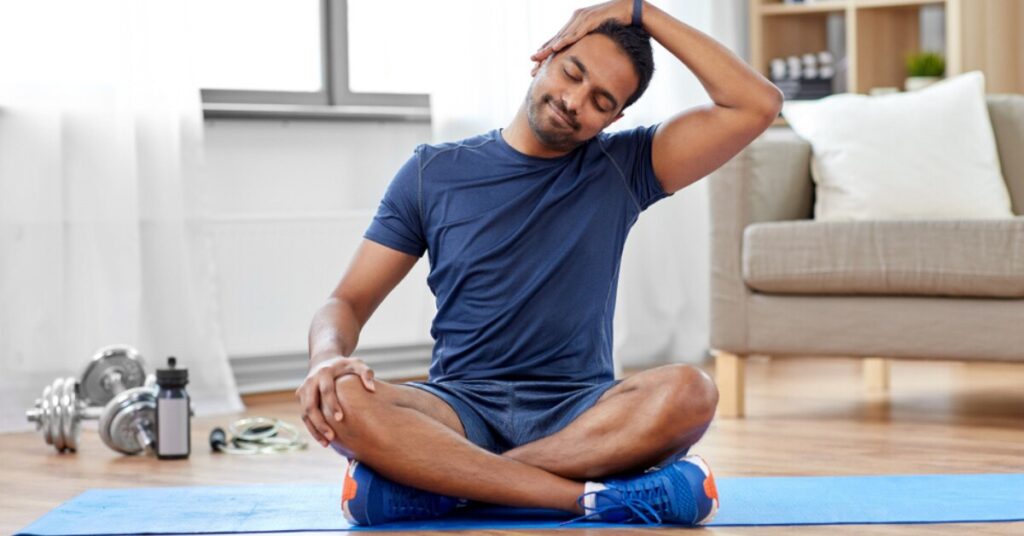Gently stretch and massage your neck muscles. Use heat therapy to soothe and relax the tension.
Neck tightness is a common issue caused by poor posture, stress, or prolonged periods of inactivity. Simple techniques can help alleviate this discomfort and prevent it from recurring. Stretching exercises, such as tilting your head side-to-side, can improve flexibility and reduce stiffness.
Massaging the neck area can enhance blood flow and ease muscle tension. Applying a warm compress or taking a hot shower can further relax tight muscles. Incorporating regular breaks and ergonomic adjustments to your workspace can also prevent neck strain. Practicing mindfulness or relaxation techniques can reduce stress, which often contributes to neck tightness. Consistently following these methods can lead to a more relaxed and pain-free neck.

Common Causes
A tight neck can be very painful. Understanding the common causes can help you find relief. Below are some of the most frequent reasons for neck tightness.
Poor Posture
Poor posture is one of the leading causes of a tight neck. Sitting or standing incorrectly puts extra strain on your neck muscles. This can cause stiffness and pain.
People often hunch over their computers or phones. This position can lead to a condition known as “tech neck”. Tech neck happens when your head is bent forward for long periods. This posture strains the neck muscles and causes them to tighten.
Common signs of poor posture:
- Slouching shoulders
- Chin jutting forward
- Rounded upper back
Improving your posture can help alleviate neck tightness. Try to sit up straight and keep your head aligned with your spine. Use ergonomic furniture to support your posture.
Stress And Anxiety
Stress and anxiety are other major contributors to a tight neck. When stressed, your body tenses up. This tension often accumulates in the neck and shoulders.
Chronic stress can make your muscles stay in a state of tension. This can lead to long-term neck pain and discomfort. Learning to manage stress can improve your neck health.
Ways stress can cause neck tightness:
- Muscle tension
- Increased heart rate
- Shallow breathing
Adopting relaxation techniques can help reduce stress. Deep breathing exercises, meditation, and yoga are excellent ways to calm your mind and body.
Initial Assessments
Experiencing a tight neck can be frustrating and painful. To address this, performing initial assessments is crucial. These assessments help pinpoint the exact issues and create a targeted plan for relief. Let’s explore how to relax a tight neck by starting with some initial assessments.
Identifying Pain Points
Start by locating the specific areas causing discomfort. Use your fingers to gently press around your neck. Identify which spots feel tender or sore. This can help focus on the most affected areas. Here are some common pain points:
- Base of the skull
- Top of the shoulders
- Sides of the neck
- Upper back
Once these pain points are identified, you can use targeted techniques to alleviate tension.
Range Of Motion Tests
Assessing your range of motion is essential in understanding neck tightness. Perform these simple tests to evaluate your flexibility:
- Forward and Backward Tilt: Slowly tilt your head forward, bringing your chin to your chest. Then, tilt your head backward, looking up at the ceiling.
- Side Tilt: Tilt your head towards each shoulder, aiming to touch your ear to your shoulder.
- Rotation: Turn your head to the left, then to the right, trying to look over your shoulder.
Track any discomfort or restrictions during these tests. This information can guide you in choosing the right exercises and stretches.
| Test | Movement | Observation |
|---|---|---|
| Forward and Backward Tilt | Chin to chest, then look up | Note any pain or stiffness |
| Side Tilt | Ear to shoulder | Identify tightness or discomfort |
| Rotation | Look over each shoulder | Check for restricted movement |
Understanding your range of motion and identifying pain points are key to developing an effective relaxation strategy.
Immediate Relief Techniques
Experiencing a tight neck can be uncomfortable and irritating. Immediate relief techniques can help ease the pain and improve your comfort level quickly. Here are some effective methods to relieve neck tension.
Heat And Cold Therapy
Applying heat or cold to the affected area can provide significant relief. Use a warm compress or a heating pad to relax tight muscles. A hot shower can also be beneficial.
Cold therapy reduces inflammation and numbs sharp pain. Try using an ice pack wrapped in a towel for 15-20 minutes. Alternate between heat and cold for better results.
Over-the-counter Pain Relievers
Over-the-counter pain relievers can help manage neck pain. Medications like ibuprofen and acetaminophen are effective. Always follow the dosage instructions on the packaging.
If you prefer natural options, consider using topical creams with menthol or capsaicin. These can provide a soothing sensation and help ease muscle tension.
| Technique | Description |
|---|---|
| Heat Therapy | Use a warm compress or heating pad for muscle relaxation. |
| Cold Therapy | Apply an ice pack to reduce inflammation and numb pain. |
| OTC Pain Relievers | Take ibuprofen or acetaminophen as per the recommended dosage. |

Stretching Exercises
Stretching exercises can help relax a tight neck. They improve blood flow and reduce tension. Here are some simple exercises to try.
Neck Tilt
Neck tilts are easy and effective. Follow these steps:
- Sit or stand with your back straight.
- Slowly tilt your head toward your right shoulder.
- Hold for 15-30 seconds.
- Return to the center.
- Repeat on the left side.
Perform this exercise 2-3 times daily. It stretches the muscles on the sides of your neck.
Neck Rotation
Neck rotation can ease tension. Follow these steps:
- Sit or stand comfortably.
- Slowly turn your head to the right.
- Hold for 15-30 seconds.
- Return to the center.
- Repeat on the left side.
Do this exercise 2-3 times daily. It helps improve neck flexibility.
Massage Methods
Dealing with a tight neck can be frustrating. Massage methods offer a simple way to find relief. Below, explore effective techniques for self-massage and the benefits of professional massages.
Self-massage
Self-massage is a convenient way to ease neck tension. You can do it at home or work without special tools.
- Use your fingers: Apply gentle pressure to sore spots. Move in circular motions.
- Use a tennis ball: Place it between your neck and a wall. Lean into the ball and roll it around.
- Stretch your neck: Tilt your head to each side. Hold the position for 20 seconds.
These techniques can improve blood flow and reduce pain. Practice them daily for best results.
Professional Massage
A professional massage can provide deeper relief. Trained therapists use specialized techniques to target tight muscles.
| Type of Massage | Benefits |
|---|---|
| Swedish Massage | Improves circulation and relaxes muscles |
| Deep Tissue Massage | Targets deeper layers of muscle for intense relief |
| Trigger Point Therapy | Releases knots and reduces specific pain points |
Professional massages can last from 30 to 90 minutes. Regular sessions can greatly improve neck mobility and reduce chronic pain.

Ergonomic Adjustments
Ergonomic adjustments can greatly help in relaxing a tight neck. Making simple changes in your daily environment can reduce neck strain and improve comfort. Here, we focus on workstation setup and proper sleeping positions.
Workstation Setup
A well-organized workstation can prevent neck tightness. Follow these tips for an ergonomic setup:
- Monitor Height: Keep your monitor at eye level. This avoids looking up or down.
- Chair Position: Use a chair that supports your back. Adjust the height so your feet are flat on the floor.
- Keyboard and Mouse: Place them close to avoid reaching. Keep your elbows at a 90-degree angle.
- Desk Height: Ensure your desk height allows comfortable arm placement. Your forearms should be parallel to the floor.
These simple changes can significantly reduce neck strain.
Proper Sleeping Positions
Proper sleeping positions are crucial for a relaxed neck. Consider these tips for better sleep posture:
- Back Sleepers: Use a thin pillow to keep your head level.
- Side Sleepers: Choose a firm pillow. It should fill the space between your ear and shoulder.
- Stomach Sleepers: Try to avoid this position. It strains the neck. If you must, use a very thin pillow or none at all.
Proper pillow and sleeping positions support your neck and reduce tightness.
Stress Management
Managing stress is crucial for relaxing a tight neck. Stress often tightens neck muscles, leading to discomfort and pain. By practicing effective stress management techniques, you can relieve tension and promote relaxation.
Mindfulness Practices
Mindfulness practices help reduce stress and loosen tight neck muscles. These practices encourage you to stay present and focused. They involve simple activities that anyone can do.
Here are some effective mindfulness practices:
- Practice meditation daily for 10 minutes.
- Engage in yoga to stretch and relax your neck.
- Take short mindfulness walks to clear your mind.
These activities help you become aware of your body and mind. They reduce stress and make your neck feel more relaxed.
Breathing Exercises
Breathing exercises are simple yet powerful techniques to manage stress. They help to oxygenate your body and calm your mind.
Follow these steps for effective breathing exercises:
- Find a quiet place to sit comfortably.
- Close your eyes and take a deep breath in through your nose.
- Hold the breath for a count of four.
- Exhale slowly through your mouth.
- Repeat this process for five minutes.
These exercises help lower stress levels and relax your neck muscles. Practice them daily for the best results.
Preventative Measures
Preventative measures can help keep your neck free from tightness and pain. Implementing these simple steps into your daily routine can make a significant difference.
Regular Breaks
Taking regular breaks is essential for preventing neck strain. If you work at a desk, make sure to stand up and stretch every 30 minutes. This can help alleviate pressure on your neck muscles.
- Set a timer to remind you to take breaks.
- Use a standing desk to reduce prolonged sitting.
- Practice simple neck stretches during your breaks.
Strengthening Exercises
Engaging in strengthening exercises can help keep your neck muscles strong. Strong muscles are less likely to become tight and strained.
- Chin Tucks: Sit or stand with your spine straight. Pull your chin towards your chest, hold for 5 seconds, and release.
- Shoulder Shrugs: Raise your shoulders towards your ears, hold for 5 seconds, and relax.
- Neck Flexion: Gently bend your head forward, bringing your chin towards your chest, hold for a few seconds, and return to the starting position.
Incorporate these exercises into your daily routine. Just a few minutes each day can make a big difference.
| Exercise | Repetitions | Duration |
|---|---|---|
| Chin Tucks | 10 | 5 seconds each |
| Shoulder Shrugs | 10 | 5 seconds each |
| Neck Flexion | 10 | 5 seconds each |
By incorporating regular breaks and strengthening exercises, you can prevent neck tightness. These preventative measures are simple yet effective in maintaining neck health.
Frequently Asked Questions
What Causes A Tight Neck?
A tight neck can be caused by poor posture, stress, or muscle strain. It often results from long hours at a desk or improper sleeping positions.
How Can I Quickly Relieve Neck Tension?
Quickly relieve neck tension by practicing gentle neck stretches, applying a warm compress, or using a foam roller. These methods help relax the muscles.
Are There Exercises To Loosen A Tight Neck?
Yes, exercises like neck tilts, shoulder shrugs, and gentle rotations can help loosen a tight neck. Practice these daily for best results.
Can Stress Cause Neck Tightness?
Stress can cause neck tightness due to muscle tension. Relaxation techniques like deep breathing or meditation can help reduce stress-related neck pain.
Conclusion
Relieving a tight neck is essential for overall well-being. Simple exercises, good posture, and regular breaks can help. Incorporate these habits into your routine for lasting relief. Remember to stay mindful of your body’s needs. Take action today to enjoy a more relaxed and comfortable neck.

